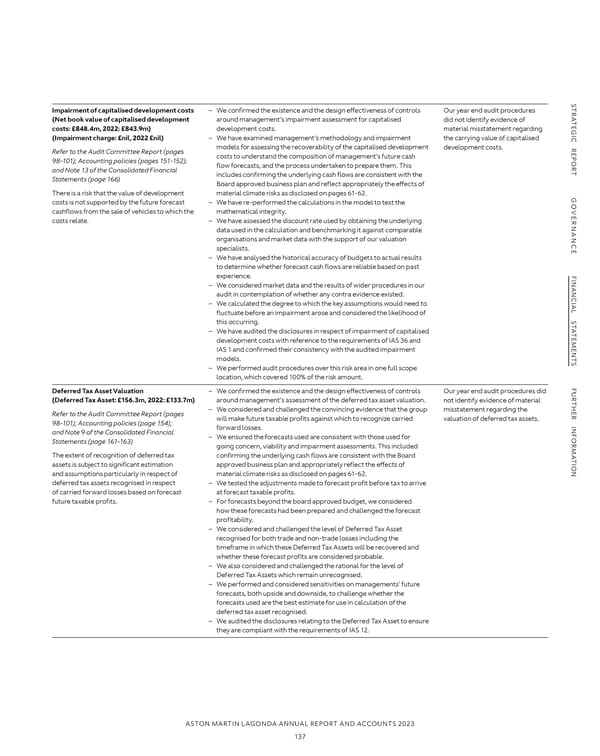S S TR Impairment of capitalised development costs – We confirmed the existence and the design effectiveness of controls Our year end audit procedures TR A A TE (Net book value of capitalised development around management’s impairment assessment for capitalised did not identify evidence of TE G costs: £848.4m, 2022: £843.9m) development costs. material misstatement regarding G I I C (Impairment charge: £nil, 2022 £nil) – We have examined management’s methodology and impairment the carrying value of capitalised C R models for assessing the recoverability of the capitalised development development costs. R E Refer to the Audit Committee Report (pages E P costs to understand the composition of management’s future cash P O 98-101); Accounting policies (pages 151-152); O R flow forecasts, and the process undertaken to prepare them. This R T and Note 13 of the Consolidated Financial T Statements (page 166) includes confirming the underlying cash flows are consistent with the Board approved business plan and reflect appropriately the effects of There is a risk that the value of development material climate risks as disclosed on pages 61-62. G G O costs is not supported by the future forecast – We have re-performed the calculations in the model to test the O VE cashflows from the sale of vehicles to which the mathematical integrity. VE R costs relate. – We have assessed the discount rate used by obtaining the underlying R NAN data used in the calculation and benchmarking it against comparable NAN organisations and market data with the support of our valuation C C E specialists. E – We have analysed the historical accuracy of budgets to actual results to determine whether forecast cash flows are reliable based on past F experience. F I I NAN – We considered market data and the results of wider procedures in our NAN audit in contemplation of whether any contra evidence existed. C C IAL – We calculated the degree to which the key assumptions would need to IAL S fluctuate before an impairment arose and considered the likelihood of S T this occurring. T A A T – We have audited the disclosures in respect of impairment of capitalised T E E M development costs with reference to the requirements of IAS 36 and M E IAS 1 and confirmed their consistency with the audited impairment E N N T models. T S – We performed audit procedures over this risk area in one full scope S location, which covered 100% of the risk amount. F F U Deferred Tax Asset Valuation – We confirmed the existence and the design effectiveness of controls Our year end audit procedures did U R R T (Deferred Tax Asset: £156.3m, 2022: £133.7m) around management’s assessment of the deferred tax asset valuation. not identify evidence of material T H – We considered and challenged the convincing evidence that the group H E misstatement regarding the E R Refer to the Audit Committee Report (pages R INF 98-101); Accounting policies (page 154); will make future taxable profits against which to recognize carried valuation of deferred tax assets. INF and Note 9 of the Consolidated Financial forward losses. OR Statements (page 161-163) – We ensured the forecasts used are consistent with those used for OR M going concern, viability and impairment assessments. This included M A The extent of recognition of deferred tax confirming the underlying cash flows are consistent with the Board A T T I I ON assets is subject to significant estimation approved business plan and appropriately reflect the effects of ON and assumptions particularly in respect of material climate risks as disclosed on pages 61-62. deferred tax assets recognised in respect – We tested the adjustments made to forecast profit before tax to arrive of carried forward losses based on forecast at forecast taxable profits. future taxable profits. – For forecasts beyond the board approved budget, we considered how these forecasts had been prepared and challenged the forecast profitability. – We considered and challenged the level of Deferred Tax Asset recognised for both trade and non-trade losses including the timeframe in which these Deferred Tax Assets will be recovered and whether these forecast profits are considered probable. – We also considered and challenged the rational for the level of Deferred Tax Assets which remain unrecognised. – We performed and considered sensitivities on managements’ future forecasts, both upside and downside, to challenge whether the forecasts used are the best estimate for use in calculation of the deferred tax asset recognised. – We audited the disclosures relating to the Deferred Tax Asset to ensure they are compliant with the requirements of IAS 12. ASTON MARTIN LAGONDA ANNUAL REPORT AND ACCOUNTS 2023 137
 Annual Report and Accounts Page 138 Page 140
Annual Report and Accounts Page 138 Page 140